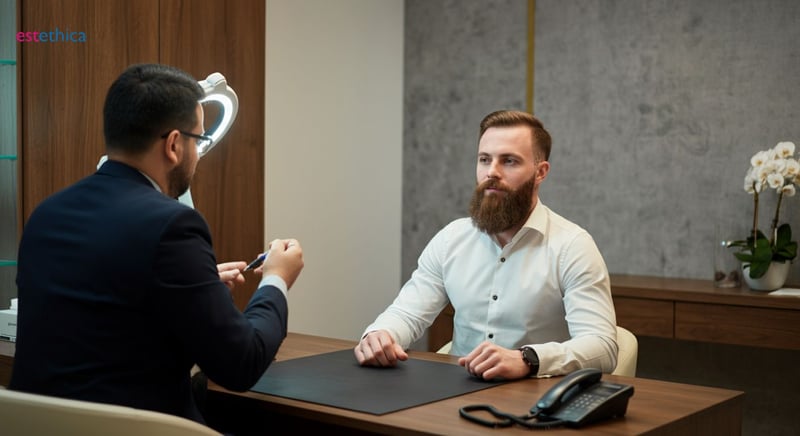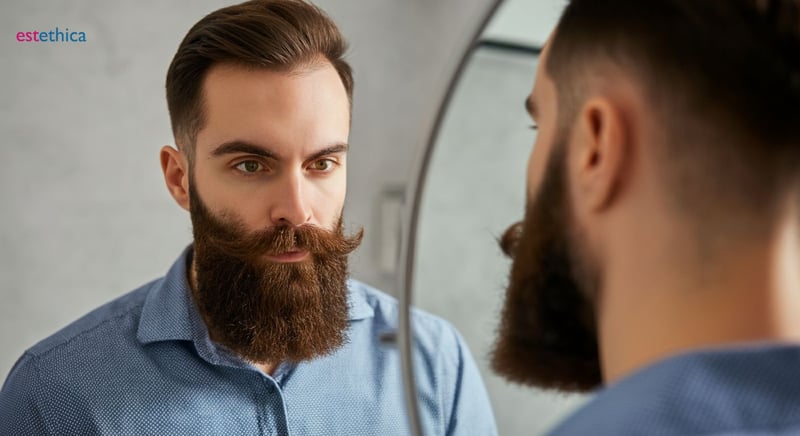Unlocking the Secrets of Beard Transplants: A Comprehensive Guide
Discover the secrets to a perfect beard with a comprehensive guide to beard transplants, including techniques, recovery, and clinic selection.
In recent years, beard transplants have gained significant popularity among individuals seeking a fuller, more robust facial hair appearance. This comprehensive guide demystifies the process, exploring everything from what a beard transplant entails to the latest techniques and recovery processes. Whether you’re looking to fill in patchy areas or achieve the stylish beard you've always dreamt of, understanding your options is the first step towards your facial hair goals.
Understanding What a Beard Transplant Entails
Key Benefits of Beard Transplants
- Enhances facial aesthetics by filling in sparse areas, creating a fuller beard appearance.
- Boosts self-confidence by providing a more mature and masculine look.
- Offers a permanent solution for those struggling with patchy facial hair.
Beard transplants have gained popularity due to their ability to transform facial aesthetics significantly. For instance, individuals with naturally thin or uneven facial hair can achieve a fuller, more uniform beard. This transformation not only enhances appearance but also boosts self-esteem, as a well-groomed beard is often associated with maturity and masculinity. Moreover, the results of a beard transplant are permanent, providing a lasting solution for those who have struggled with patchy facial hair. This procedure is particularly beneficial for individuals who have experienced facial hair loss due to genetics, scarring, or other factors.
Steps Involved in a Beard Transplant Procedure
- Consultation: Discuss goals and assess facial hair needs with a specialist.
- Follicle Harvesting: Extract hair follicles from the donor site, usually the scalp.
- Transplantation: Implant follicles into the beard area to achieve desired density.
The process of a beard transplant begins with a thorough consultation where the specialist evaluates the individual's facial hair needs and discusses the desired outcome. Following this, hair follicles are meticulously harvested from a donor site, typically the scalp, using advanced techniques to ensure minimal scarring and optimal graft survival. The final step involves the careful implantation of these follicles into the beard area, strategically placed to mimic natural hair growth patterns. This meticulous approach ensures that the transplanted hair blends seamlessly with existing facial hair, resulting in a natural and aesthetically pleasing appearance.

Exploring the Latest Techniques in Facial Hair Restoration
Innovative Methods in Beard Transplantation
Modern beard transplant techniques like Follicular Unit Extraction (FUE) and Direct Hair Implantation (DHI) have revolutionized facial hair restoration. FUE involves extracting individual hair follicles and implanting them into the beard area, ensuring a natural look. DHI, a variant of FUE, uses specialized tools for direct implantation, reducing graft handling and minimizing scarring risks. These methods cater to the growing demand for natural growth patterns and optimal aesthetic results.
Advantages of Advanced Beard Transplant Techniques
- Minimized scarring due to precise follicle extraction and implantation.
- Enhanced natural appearance by mimicking natural hair growth patterns.
- Reduced recovery time, allowing quicker return to daily activities.
These advanced techniques offer significant benefits, including minimized scarring and a more natural appearance. By mimicking natural hair growth patterns, they ensure that the transplanted hair blends seamlessly with existing facial hair. Additionally, the reduced recovery time allows individuals to resume their daily activities sooner, making these procedures more appealing.
- Preparation: Assess donor and recipient areas for optimal results.
- Extraction: Use FUE or DHI to harvest follicles with precision.
- Implantation: Carefully place follicles to achieve desired beard density.
The process begins with a thorough assessment of both donor and recipient areas to ensure optimal results. Using FUE or DHI, follicles are harvested with precision, minimizing damage and maximizing survival rates. The final step involves the careful placement of these follicles to achieve the desired beard density, ensuring a natural and aesthetically pleasing outcome.

Navigating the Recovery Process After Beard Surgery
Essential Post-Operative Care Tips
After undergoing a beard transplant, adhering to post-operative care instructions is crucial for optimal results. Patients often experience minor swelling and redness, which typically subside within a few days. To ensure the successful establishment of newly implanted follicles, it's important to follow specific guidelines.
- Avoid vigorous facial exercises to prevent strain on the treated area.
- Protect the transplanted region from direct sunlight to minimize irritation.
- Maintain a gentle skincare routine to support healing and follicle growth.
These measures not only aid in recovery but also enhance the overall outcome of the procedure. For instance, avoiding strenuous activities reduces the risk of dislodging newly implanted follicles, while sun protection helps prevent potential damage to sensitive skin. A gentle skincare routine, including mild cleansers and moisturizers, supports the healing process and promotes healthy follicle development.
Understanding the Recovery Timeline
The recovery timeline for a beard transplant varies among individuals, but generally follows a predictable pattern. Initially, patients may notice some redness and swelling, which typically diminish within a week. During this period, it's essential to be patient and allow the body to heal naturally.
- First Week: Experience minor swelling and redness; avoid touching the treated area.
- Second Week: Notice shedding of transplanted hairs, a normal part of the process.
- Third to Fourth Week: Begin to see new hair growth as follicles establish themselves.
This timeline highlights the gradual progression of recovery, emphasizing the importance of patience and adherence to care instructions. For example, during the first week, avoiding contact with the treated area helps prevent irritation. In the second week, shedding of transplanted hairs is a natural occurrence, signaling the start of new growth. By the third to fourth week, patients often observe the emergence of new facial hair, marking the successful establishment of transplanted follicles.

Choosing the Right Clinic for Your Beard Transplant Journey
Evaluating Clinic Expertise and Technology
When selecting a clinic for your beard transplant, it's crucial to evaluate the expertise of the surgeons and the technology they use. Clinics with a strong track record in facial hair restoration often employ advanced techniques and state-of-the-art equipment, ensuring optimal results. For instance, a clinic that utilizes the latest in Follicular Unit Extraction (FUE) technology can offer more precise and natural-looking outcomes. Additionally, clinics that invest in continuous training for their staff demonstrate a commitment to maintaining high standards of care.
- Check the surgeon's credentials and experience in beard transplants.
- Assess the clinic's use of cutting-edge technology for facial hair restoration.
- Look for clinics that prioritize ongoing staff training and development.
These factors not only contribute to the success of the procedure but also enhance the overall patient experience. For example, a clinic with experienced surgeons and advanced technology is more likely to achieve a seamless integration of transplanted hair with natural growth patterns. Furthermore, clinics that emphasize staff training are better equipped to handle any complications, ensuring a smoother recovery process.
Understanding the Importance of Patient-Centered Care
Patient-centered care is a critical aspect of choosing the right clinic for your beard transplant. This approach focuses on tailoring the treatment to meet individual needs and preferences, ensuring a comfortable and satisfying experience. Clinics that prioritize patient-centered care often provide comprehensive consultations, where they discuss the patient's goals and expectations in detail.
- Initial Consultation: Discuss personal goals and assess suitability for the procedure.
- Customized Treatment Plan: Develop a plan tailored to the patient's unique facial structure and hair growth patterns.
- Post-Procedure Support: Offer guidance and support throughout the recovery process.
This personalized approach not only enhances the outcome of the beard transplant but also fosters a trusting relationship between the patient and the clinic. For instance, during the initial consultation, a thorough discussion about the patient's desired results helps set realistic expectations. A customized treatment plan ensures that the procedure is aligned with the patient's facial features, leading to a more natural appearance. Additionally, ongoing support during recovery helps address any concerns, contributing to a positive overall experience.
The Permanence and Effectiveness of Beard Transplants
Understanding the Longevity of Beard Transplants
Beard transplants offer a permanent solution for those seeking to enhance their facial hair. Once the transplanted follicles establish themselves, typically over several months, the results are long-lasting. This permanence makes beard transplants a valuable investment for individuals committed to altering their appearance. For example, a man with patchy facial hair can achieve a fuller beard that remains consistent over time, provided he maintains proper care.
- Transplanted follicles adapt to the beard area, ensuring continuous growth.
- Permanent results eliminate the need for temporary solutions like topical treatments.
- Long-term satisfaction as the beard maintains its density and appearance.
These benefits highlight why many choose beard transplants over other methods. Unlike temporary solutions, transplanted hair continues to grow naturally, providing a consistent and reliable outcome. This permanence is particularly appealing to those who have struggled with facial hair inconsistencies, as it offers a definitive resolution to their concerns.
Factors Influencing the Success of Beard Transplants
The success of a beard transplant depends on several factors, including the skill of the surgeon and the patient's adherence to post-operative care. Skilled surgeons ensure that follicles are placed strategically to mimic natural growth patterns, enhancing the overall appearance. Additionally, following care instructions is crucial for the follicles to establish themselves effectively.
- Surgeon's Expertise: Affects the precision of follicle placement and overall results.
- Post-Operative Care: Essential for the survival and growth of transplanted follicles.
- Patient's Health: Influences healing and the integration of transplanted hair.
These factors collectively determine the success and satisfaction of the procedure. For instance, a patient who diligently follows post-operative guidelines is more likely to experience optimal growth and minimal complications. Similarly, a surgeon's expertise can significantly impact the natural appearance of the transplanted beard, ensuring it blends seamlessly with existing facial hair.
Celebrity Beard Transplants and Cultural Trends
The Influence of Celebrity Beard Transplants
Celebrity beard transplants have significantly influenced cultural perceptions of masculinity and style. As public figures embrace these procedures, they set trends that resonate with fans worldwide. For instance, a well-known actor's transformation can inspire countless individuals to consider similar enhancements, viewing a full beard as a symbol of confidence and modernity.
- High-profile transformations often lead to increased interest in beard transplants.
- Media coverage amplifies the appeal of facial hair restoration techniques.
- Celebrity endorsements can shift societal norms around male grooming.
This phenomenon highlights the power of celebrity influence in shaping grooming trends. As more public figures opt for beard transplants, the procedure gains mainstream acceptance, encouraging men to explore surgical options for achieving their desired facial hair aesthetics.
Cultural Shifts in Beard Aesthetics
The growing popularity of beard transplants reflects broader cultural shifts in how masculinity and personal style are perceived. In recent years, a well-groomed beard has become synonymous with fashion-forward thinking and individuality. This change is partly driven by the diverse representations of masculinity in media and popular culture.
- Media Representation: Diverse portrayals of men with beards in films and advertisements.
- Fashion Trends: Increasing emphasis on facial hair as a key style element.
- Social Media Influence: Platforms showcasing varied beard styles and grooming tips.
These cultural dynamics encourage men to view facial hair as a form of self-expression, leading to a rise in demand for procedures like beard transplants. As societal norms evolve, the emphasis on personal grooming and style continues to grow, making facial hair restoration a sought-after option for those looking to enhance their appearance.
Innovative Beard Transplant Techniques: FUE and DHI
Comprehensive Beard Transplant Process: From Consultation to Recovery
Frequently Asked Questions
What is a beard transplant and how does it work?
What are the latest techniques in facial hair restoration?
Is a beard transplant permanent?
What should I expect during the recovery process after a beard transplant?
How do I choose the right clinic for my beard transplant?
Discover the path to your healthiest and most beautiful self with estethica's award-winning services. Call now for a free consultation and experience world-class care.
📞 Call for Your Free Consultation